A Greener Lawn
Reducing the Carbon Footprint of Your Lawn Mower
A beautifully manicured landscape – with green lawns, calming water features, flowering trees, and immaculate edging – is not the leading cause of air pollution in the United States. But it’s not last: far from it. That’s because achieving curbside appeal requires powered equipment. A fleet of powered equipment, in fact; and such equipment is rarely conducive to greener living. This article will detail the impact of lawn mowers and lawn equipment, help improve your water and gas usage, and teach you how to maintain your lawn mower parts to enhance their efficiency.
Lawn equipment belches out nitrogen oxide and volatile organic compounds 11 times more toxic than an automobile. Meanwhile, homeowners focus on their fountains. They linger on their lawns. They rationalize the ends to justify the greens with quips like, “beauty is pain,” or “expensive, but worth it,” without considering the price paid by our planet.
The Environmental Price
So, just how expensive is it? According to the U.S. Environmental Protection Agency, five percent of air pollution in the United States comes from cutting the grass. That doesn’t include damage caused by chemical fertilizers, leaf blowers, snow throwers, hedge trimmers, or grass clippers. And it definitely doesn’t mention water sprinklers, which are essential for managing a lawn’s seemingly unquenchable thirst.
Some Unpleasant Facts
Emissions come from more than automobiles: Four of the primary components in air pollution are hydrocarbons, particulates, carbon dioxide, and carbon monoxide. The emissions from using your lawn mower for one hour are roughly the same as driving your car 40 miles.
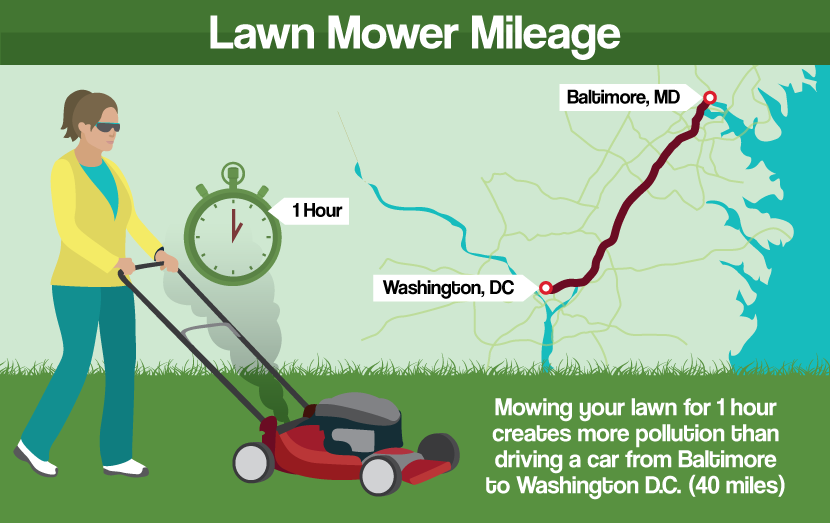
Spills can kill: Americans use about 600 million gallons of gasoline each year in their yard care equipment. If this isn’t startling enough, more than 17 million gallons of this fuel end up on the ground (from spills). Many experts are more concerned about the damage caused by all of this spilled fuel than by the fuel that is actually burned by our lawn equipment. With good reason: spilled fuel releases hydrocarbons into the atmosphere and contaminates soils, and potentially, ground water.
Grass is a thirsty plant: According to the Utah State University Extension, a typical bluegrass lawn requires one to two inches of water each week (depending on the season). Thirty to sixty percent of all urban water is used to irrigate lawn turf. These water volumes (used solely for irrigation) simply are not sustainable, given the ever-growing population and urban sprawl. This is especially true in the western U.S., where ongoing drought has nearly depleted water supplies in many areas.
That’s the bad news.
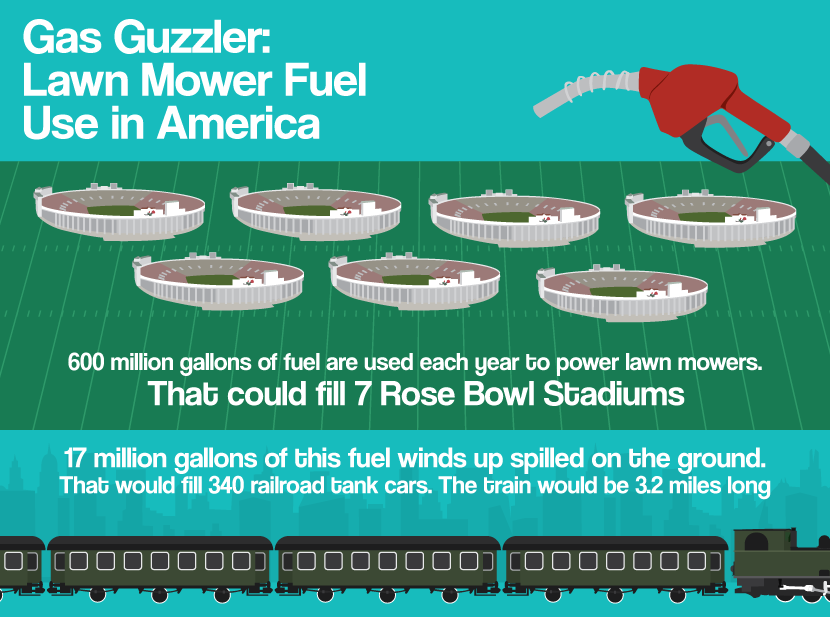
Regulations for the Future
The good news is that you don’t have to rip out your lawn or call in a concrete specialist to become part of the solution. In the past 20 years, there have been significant improvements in the outdoor power equipment industry. There are now more options than ever when it comes to green (and greener) lawnmowers. Following are some additional ideas that will allow you to build a barefoot lawn without building your carbon footprint.
Prior to 1996, small engine emissions were unregulated. Since that time, the EPA and other environmental regulatory bodies such as C.A.R.B. (California Air Resource Board) have implemented regulations that have steadily improved the emissions of all small engines. The EPA’s Phase 3 regulations govern traditional small engine exhaust emissions, as well as the evaporative emissions of the engine’s fuel system. Carbon filters now capture almost all of the hydrocarbons that once evaporated into the air from the mower’s fuel tank and breathers.
Ironically, a mower that was “built to last” a decade ago is the last thing you want to use on your lawn today. That’s because early gas-powered mowers are far less environmentally efficient than the newest models on the market.
Improvements have also occurred in the “alternative energy” segment of the modern mower market. Once considered inferior and underpowered by small-engine enthusiasts, electric and cordless mowers are garnering new respect. Technological advancements to cordless models, in particular, have resulted in lighter mowers, longer run-times, and pleasingly powerful performance. There are also a variety of enticing and environmentally efficient cordless string trimmers, blowers, and edgers available to expand your carbon-free fleet.
The Reel Mower Is Still the Cutting Edge
Despite technological advancements and electrical enhancements, the future has yet to reveal a greener machine than the original “reel” mower. Rescued from the brink of extinction, this timeless and traditional mower still stands as an exclusive alternative to energy dependence and environmental hostility. Check out the chart below to compare lawn cutting options, adjusted for the average american lawn size.
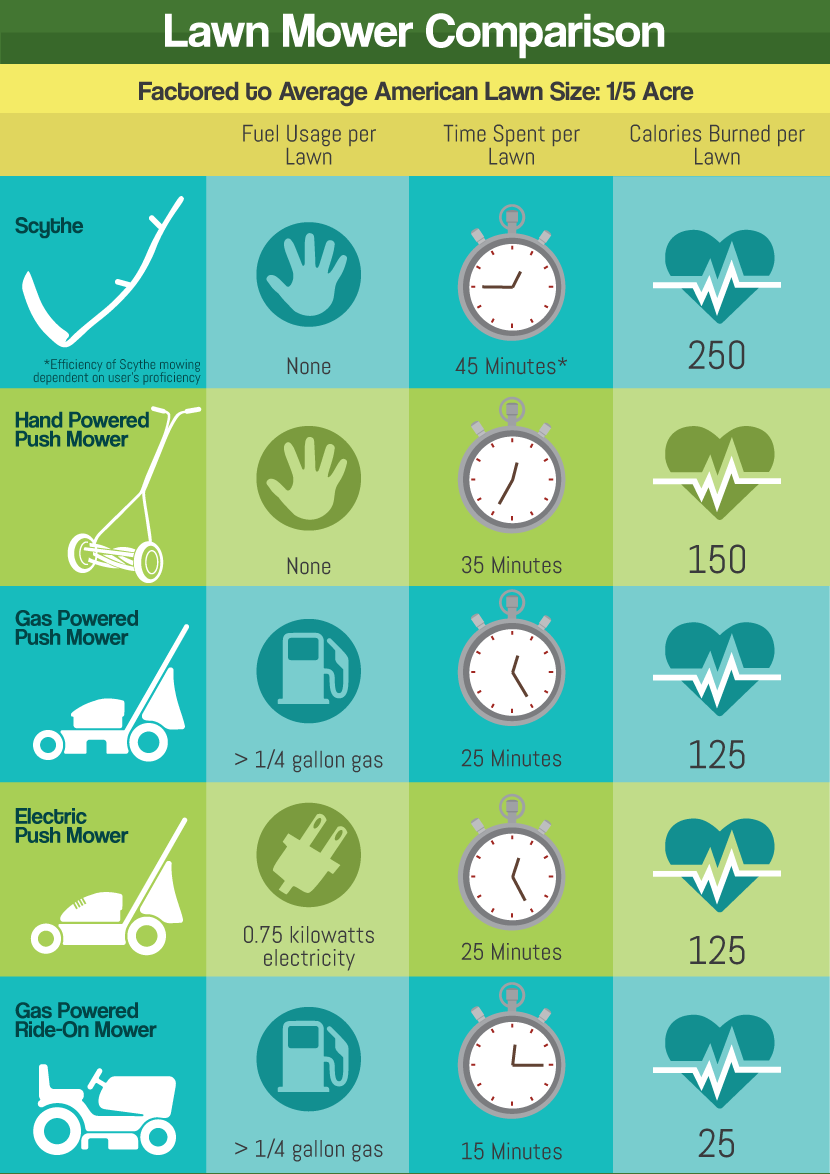
Reel mowers also provide benefits to the grass, because the rotating blades lift and cut each individual blade of grass, which creates cleaner and smoother cuts than deck-style mowers. This unique cutting action comes with some compromise, however, including mower blades that require more frequent sharpening than straight blades.
Mower Maintenance Is Key To Reducing Its Carbon Footprint
Speaking of sharpening, here are a few more power tool tips that can deliver powerful environmental benefits:
Maintain your lawn equipment: While there are numerous sources available for lawn mower parts and lawn tractor parts, it is wise to replace worn or damaged components with original equipment (OEM) whenever possible. Using original equipment replacement parts simplifies installation, reduces incidental damages and leaks, and ensures that your machines continue to perform at the environmental and operational levels established by the manufacturer.
Sharpen or replace your blades often: Dull mower or edger parts like blades decrease engine efficiency, which can lead to early engine failure, excessive fuel consumption, and increased emissions.
Sharpen or replace the blades on your mower or edger at least yearly.
Inspect and replace your air filters often: Dirty air filters cause engines to run rich, significantly increasing exhaust emissions. Inspect your air filters regularly to optimize engine performance and efficiency.
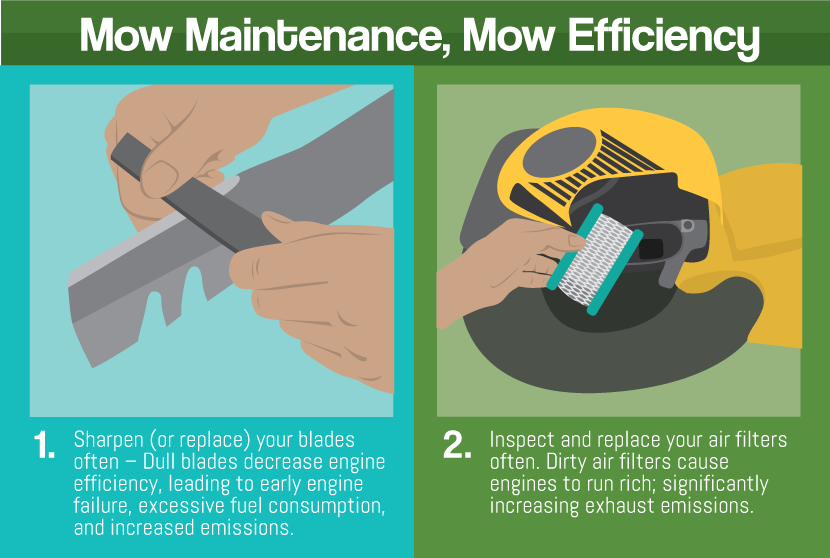
Whether powered by electricity, petroleum, or elbow grease, your equipment (and the environment) will benefit tremendously from the simple maintenance tips described above. But it takes more than well-oiled machines to garner greener pastures.
Here are some environmentally-friendly landscaping practices for you to peruse in pursuit of a more pristine planet. Some of these changes can be implemented immediately, and some will require building from the ground up.
The Thirstiest Grass in America
The majority of lawns in the U.S. are Kentucky bluegrass or a bluegrass blend. Kentucky bluegrass is actually native to Europe. It was brought to North America by early settlers, likely due to its ability to spread and form a thick and dense sod.
However, a luscious lawn is a thirsty lawn, and Kentucky bluegrass is the heavyweight champion of grass-guzzlers.
If you live in a four-season climate, expect to sprinkle more than an inch of water each week onto your bluegrass during the spring and autumn months, and up to three inches each week at the peak of summer. That is a lot of water – too much for many of the nation’s growing urban centers.
If you are installing a new landscape or remodeling an existing yard, consider using a native grass instead of the traditional Kentucky bluegrass. Many local nurseries and sod farms offer grass varieties that are native to their locales. Native grasses are perfectly suited to their particular region, so they use less water than their non-native counterparts. One great grass, that may do better in your particular region is Buffalo Grass.
In fact, during periods of normal rainfall, native grasses might not need additional watering at all. Most native grasses are slower growing and require less mowing and maintenance than traditional blends. Many communities have water-wise display gardens that you can visit to see and feel these native grasses. Some cities even offer subsidies to help cover the cost of installing water-wise lawns and plants.
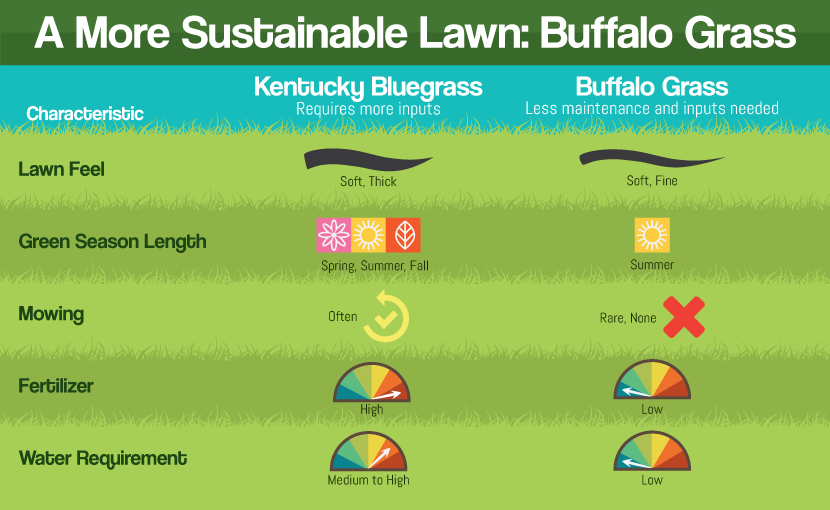
Water Conservation Begins Beneath Your Lawn
One of the simplest ways to conserve water is to identify the type of soil in your yard, and adjust your watering patterns accordingly. Lawns planted on dense, clay soil should be watered deeply and less frequently: two or three times a week is sufficient. Your goal for watering clay soils is to get the water deep into the ground. This encourages the lawn’s roots to grow deeper in search of moisture. A strong, deep root system helps the lawn endure the intense heat and drought of mid-summer. Clay does an excellent job of retaining moisture, which means that you don’t have to water as often, as long as the water you do provide is penetrating deeply into the soil.
Quick Draining. Quick Drying. Quick Dying.
Lawns planted on sandy soil should be watered more frequently, for shorter amounts of time. Sandy soils allow water to seep quickly and deeply into the ground; far beyond the reach of the lawn’s roots. Hydrate sandy soils every other day and every day during summer months, to protect the shallow root structure. Your goal for watering sandy soils is to allow the moisture to seep no more than four inches into the soil. Any more than this will drain away as waste.
Conveniently Conservative
A popular conversation in the field of conservation regards the installation of an automatic sprinkler system. Certainly, automatic sprinklers are convenient. But they also facilitate conservation by delivering finely tuned showers at precisely timed hours.
The amount of water lost to evaporation can be substantial, especially when watering during the hottest part of the summer, at the hottest time of day. Watering at night is an excellent way to conserve. In fact, many communities have established laws or codes prohibiting daytime watering, with exceptions for manually controlled sprinkler systems.
Optimize your water usage by adjusting sprinklers to activate during the final few hours of the night, just before dawn. This eliminates wasteful evaporation, yet encourages the beneficial evaporation of any water that has pooled on the surface of the lawn, as pooled water can cause mold to grow.
Most modern sprinklers – whether automatic or manual – allow adjustments for distance and radius. Familiarize yourself with these settings and adjust each sprinkler to prevent overspray.
Believe me, no matter how much you water your concrete, sidewalk or sidewalls; they simply will not grow.
Remember, sprinklers are easily knocked out of alignment. Lawnmowers, snowplows, and children’s bikes are notoriously hard on sprinkler heads. Take a few minutes each spring to test and adjust your sprinkler system.
Pressurization is another conservation consideration. Sprinkler heads that are over-pressurized can produce a mist so fine that it often evaporates before reaching the lawn. Eliminate wasteful spray by ensuring that your system is designed to work within the pressure specifications of your chosen sprinkler heads. Several manufacturers are now producing ultra-efficient sprinkler heads, which incorporate automatic pressure reducers and deliver consistent coverage patterns regardless of on-site pressure fluctuations.

Fertilizers and Herbicides
When it comes to an environmentally greener lawn, thirst comes first. But lawns are huge plants, and huge plants have huge appetites. Most people satiate their languishing lawns by applying chemical fertilizer. In fact, more than 7 million tons of petroleum-based fertilizer is used each year in the United States alone. Grasses may turn green with gratitude after a feeding, but the environment often suffers when chemical fertilizers are applied excessively or incorrectly. A healthier alternative is to use organic fertilizer, which is made from animal waste.
There are chemical-free alternatives available for controlling weeds, as well. Corn gluten, for example, can be used as a pre-emergent weed control. Over time, corn gluten can provide a nearly weed-free lawn.
A Responsible Lawn
There are choices you can make about your lawn to make your landscape more environmentally responsible. Many homeowners love the look of a short lawn, because each blade of grass stands perfectly straight, creating a tidy and formal carpet of green. Short-cut grass, however, can be a shortcut to disease, dehydration, and increased water and fertilizer consumption. Cutting your lawn to a reasonable length – such as 2.5 to 3 inches – will produce green results without overextending environmental resources, especially during the hottest summer months.
Perhaps the most significant step you can take toward greener yard care is to evaluate your needs. Depending on your lifestyle, a large lawn may or may not make sense. If you are raising a large family, you may cherish the recreational opportunities a large lawn can provide. However, if your children are grown or you’re out on your own, you might want to consider having less lawn in your yard. Let your life’s landscape determine how much lawn you really need.
A low-maintenance landscape can be created by increasing the size of your tree and shrub planting areas while decreasing the size of your lawn. Smaller lawns are simpler to mow, less expensive to manage, and as beautiful as the time you put into them.
Is it possible to have a green landscape and a green planet? That’s for you to decide. You can start by implementing some of the ideas above. Start small at first; get out there and adjust your sprinkler heads and reset your timers for 2:00AM instead of 2:00PM.
Try using an organic fertilizer this year. Grow your grass a little taller this summer. And when it’s time to replace your mower, pay attention to the emission labels. Consider alternative energy. Go cordless. Or, go get some exercise while exercising greener judgement with a traditional reel-style mower.
Zero-emissions vehicles can only help erase our carbon tire tracks. If you want to reduce your overall carbon footprint – immediately, tangibly, and significantly – consider changing the way you plan and maintain your landscape. A greener planet starts in your own backyard. Literally.
Embed the article on your site

